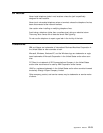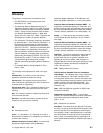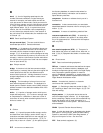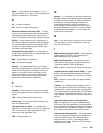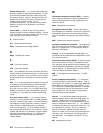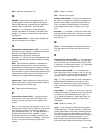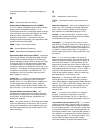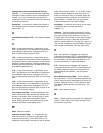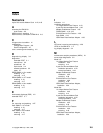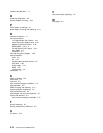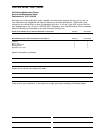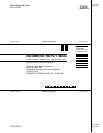Transmission Control Protocol/Internet Protocol
(TCP/IP). (1) A set of protocols that allow cooperating
computers to share resources across a heterogeneous
network. (2) A set of communication protocols that
support peer-to-peer connectivity functions for both local
and wide area networks.
twisted pair. A transmission medium that consists of
two insulated electrical conductors twisted together to
reduce noise. (T)
U
unshielded twisted pair (UTP). See
telephone twisted
pair
.
V
V.24. In data communications, a specification of the
CCITT that defines the list of definitions for interchange
circuits between data terminal equipment (DTE) and
data circuit-terminating equipment (DCE).
V.25. In data communications, a specification of the
ITU-TS that defines the automatic answering equipment
and parallel automatic calling equipment on the General
Switched Telephone Network, including procedures for
disabling echo controlled devices for both manually and
automatically established calls.
V.35. In data communications, a specification of the
CCITT that defines the list of definitions for interchange
circuits between data terminal equipment (DTE) and
data circuit-terminating equipment (DCE) at various data
rates.
V.36. In data communications, a specification of the
CCITT that defines the list of definitions for interchange
circuits between data terminal equipment (DTE) and
data circuit-terminating equipment (DCE) at rates of 48,
56, 64, or 72 kilobits per second.
vital product data (VPD). Product identification infor-
mation that describes the hardware and software com-
ponents in the product. VPD is used to assist in asset
and inventory control, performing problem determi-
nation, identifying service levels, and ensuring proper
hardware and software compatibility levels.
W
WAN. Wide area network.
wide area network (WAN). (1) A network that pro-
vides communication services to a geographic area
larger than that served by a local area network or a
metropolitan area network, and that may use or provide
public communication facilities. (T) (2) A data commu-
nications network designed to serve an area of hun-
dreds or thousands of miles; for example, public and
private packet-switching networks, and national tele-
phone networks. Contrast with
local area network
(LAN)
and
metropolitan area network (MAN)
.
workstation. A functional unit at which a user works.
A workstation often has some processing
capability. (T)
wrap test. A test that checks attachment or control
unit circuitry without checking the mechanism itself by
returning the output of the mechanism as input; for
example, when unrecoverable communication adapter
or machine errors occur, a wrap test can transmit a
specific character pattern to or through the modem in a
loop and then compare the character pattern received
with the pattern transmitted. See also
optical wrap
.
X
X.21. An International Telegraph and Telephone
Consultative Committee (CCITT) recommendation for a
general-purpose interface between data terminal equip-
ment and data circuit-terminating equipment for syn-
chronous operations on a public data network.
X.25. An International Telegraph and Telephone
Consultative Committee (ITU-TS) recommendation for
the interface between data terminal equipment and
packet-switched data networks. See also
packet
switching
.
Xerox Network Services (XNS). A Xerox Network
Services protocol. This term collectively describes the
suite of internet protocols developed by the Xerox Cor-
poration. Although similar to TCP/IP protocols, XNS
uses different packet formats and terminology. See
also
IPX
.
XNS. Xerox Network Services.
Z
zone. A logical grouping of hosts within the AppleTalk
internet. A zone name is a 32 ASCII character string
that identifies each node.
Glossary X-7



